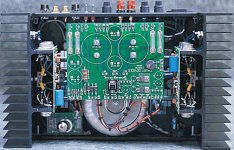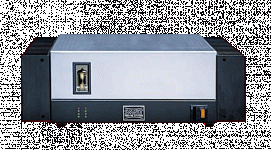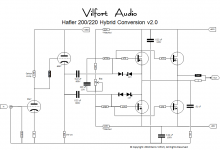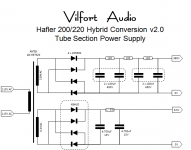Has anyone considered turning a Hafler DH220 or DH200 into a tube hybrid amp? Not to get anyone upset but they are inexpensive to acquire and pretty wide up for a mod of this type once you gut the interior circuit board and it is not like there are not many others available so you are not killing a really rare collectable.
Thoughts
It would be quite hard. If you are speaking of a tube input stage, then you need room for the iron and circuits. With the way the heat sink outputs stick into the center, way too tight. Besides, even stock it is far cleaner than any tube buffer, splitter and driver stage. Far better candidate for reuse for a chip-amp or DIY design that makes use of the big transformer and caps.
I bought mine in perfect working condition for $120 two weeks ago. Sound wise not high end but great candidate for a revamp since it was so cheap. Maybe JLH or something like that. I must say i believe you can squeeze a tube in there for the fun of it if you wanted since it would require a board revamp anyway. when i got the amp (DH220) i checked it over and it is hitting alls its required voltages so i put it into my system and felt immediately that it would need considerablly more to make me happy. i will first do the realistic mods suggested by slowhand (if i remembered correctly) earlier on in the thread along with changing every cap. if that does bring the sound more alive, smooth and even handed I willbe gutting this baby. Most likely JLH will be the next stop. After that if it I find a second one of these, I gut both and turn them into mono block diy moscode or similar.
I bought mine in perfect working condition for $120 two weeks ago. Sound wise not high end but great candidate for a revamp since it was so cheap.
You can't buy heat sinks, chassis and transformer for less than that.
You can't buy heat sinks, chassis and transformer for less than that.
I guess it depends on what you are looking for and how you build. The way I build I could not buy for that cheap with that clean as a look. Further the time to fabricate and assemble is saved as it pertains to the chassis. IMHO
driver replacement
Hi!
Reading back the previous posts I have seen that many of you consider the 3440/5415 a weak point in the Hafler circuit. A suggestion I have seen is to change them with 2SA1209 and 2SC2911. Is it really a sensible sonic improvement? Are there other candidates?
Ciao
Paolo
Hi!
Reading back the previous posts I have seen that many of you consider the 3440/5415 a weak point in the Hafler circuit. A suggestion I have seen is to change them with 2SA1209 and 2SC2911. Is it really a sensible sonic improvement? Are there other candidates?
Ciao
Paolo
Hi djk,
I agree with what you are saying, but I think that the secondary fuses ought to be installed between the secondary and the rectifiers. There, any resistance is actually useful in reducing the very high current charging peaks, and they will not affect the sound like they will between the filter caps and the circuit.
All,
I must say that I'm not a fan of increasing the value of filter capacitors greatly. The chances for improper routing for the high current spikes is increased for one. If the original capacitors are fine, leave it all alone. If they are degraded, replace them. One thing for sure is higher capacitance doesn't buy you anything as long as the existing caps are fine. The amplifier feedback network will ensure good low frequency performance. And yet, this seems to be where most hacker technicians start.
-Chris
I agree with what you are saying, but I think that the secondary fuses ought to be installed between the secondary and the rectifiers. There, any resistance is actually useful in reducing the very high current charging peaks, and they will not affect the sound like they will between the filter caps and the circuit.
All,
I must say that I'm not a fan of increasing the value of filter capacitors greatly. The chances for improper routing for the high current spikes is increased for one. If the original capacitors are fine, leave it all alone. If they are degraded, replace them. One thing for sure is higher capacitance doesn't buy you anything as long as the existing caps are fine. The amplifier feedback network will ensure good low frequency performance. And yet, this seems to be where most hacker technicians start.
-Chris
Funny, this idea of converting a Hafler to a hybrid is something I have thinking about for a while as well.
Just finished re-building a Hafler 200 and I have parts for the second 200... This is intended to be the tube driven version. My plan is to do A and B tests to really hear what improvements can be had by using a tube VAS and tube driver.
For VAS and driver, my plan is to leverage the Broskie Aikido amp design: http://www.tubecad.com/2004/blog0011.htm
It has a nivc e low number of parts and is a very detail-rich amp since it has no plate resistors to color the sound. There is that small problem that it IS a SRPP setup (followed by a constant current sourced cathode follower). Some folks hate the sound of an SRPP... Still, I will try the Aikido configuration and point to point wire it. A 6SL7 for VAS followed by a 6SN7 running @ 8-10mA should yield an output impedance of circa 250 ohms. This should be low enough to drive the MOSFETs. All we need on the output stage is a nice BIAS circuit. The tube section will be coupled to the outputs via two .22uF caps and the BIAS feeding resistors will be 220K to 470K for a good high-pass filter. Would really like to go DC here, but that would require a +/- power supply for the tubes. Besides I am a little concerned about drift as the tubes age. So for now, let's go w/ a cap.
So there you have it desperateaudio... These are my thoughts. I will post an update as the project moves fwd.
Just finished re-building a Hafler 200 and I have parts for the second 200... This is intended to be the tube driven version. My plan is to do A and B tests to really hear what improvements can be had by using a tube VAS and tube driver.
For VAS and driver, my plan is to leverage the Broskie Aikido amp design: http://www.tubecad.com/2004/blog0011.htm
It has a nivc e low number of parts and is a very detail-rich amp since it has no plate resistors to color the sound. There is that small problem that it IS a SRPP setup (followed by a constant current sourced cathode follower). Some folks hate the sound of an SRPP... Still, I will try the Aikido configuration and point to point wire it. A 6SL7 for VAS followed by a 6SN7 running @ 8-10mA should yield an output impedance of circa 250 ohms. This should be low enough to drive the MOSFETs. All we need on the output stage is a nice BIAS circuit. The tube section will be coupled to the outputs via two .22uF caps and the BIAS feeding resistors will be 220K to 470K for a good high-pass filter. Would really like to go DC here, but that would require a +/- power supply for the tubes. Besides I am a little concerned about drift as the tubes age. So for now, let's go w/ a cap.
So there you have it desperateaudio... These are my thoughts. I will post an update as the project moves fwd.
What sort of dollars needs to be spent to mod these amps and how much improvement is gained?
I have a dh-200 and dh-220 with matching pre's and just wondering if it's worth spending money on them.
I have also found mod kits on ebay for the above amps and pre's, the feedback seems positive in terms of bang for buck. Any comments from you guys in relation to such upgrade kits would be appreciated.
Cheers.
I have a dh-200 and dh-220 with matching pre's and just wondering if it's worth spending money on them.
I have also found mod kits on ebay for the above amps and pre's, the feedback seems positive in terms of bang for buck. Any comments from you guys in relation to such upgrade kits would be appreciated.
Cheers.
Last edited:
It all depends on what you are shooting for. I personally like the sound of tubes and have designed a bunch of 300B SE, 300B P-P and EL34 P-P amps. So for me fooling around with a tube conversion of an old Hafler seemed a fun project. It sounds great too: all the warmth and detail of tubes and the bass slam of a nice solid state output. I guess that's why folks like their Moscodes and Moskidos. Is it worth it? I say yes. This is of course a matter of taste. But you can take any old Hafler and make it sound better by upgrading caps on the driver board and bypassing/replacing the power supply caps. Cost? The Hafler should run you $70-$130 on Ebay and figure $50 to $100 for the extra parts (assuming the output MOSFETs are OK). What you end up with is a great sounding class AB amp that can go toe to toe with amps costing 10-20 times more. I have included the schematic for the Hafler tube conversion if you want to go that route (notice the zero feedback design and Aikaido-like tube section - Thx Broskie!).
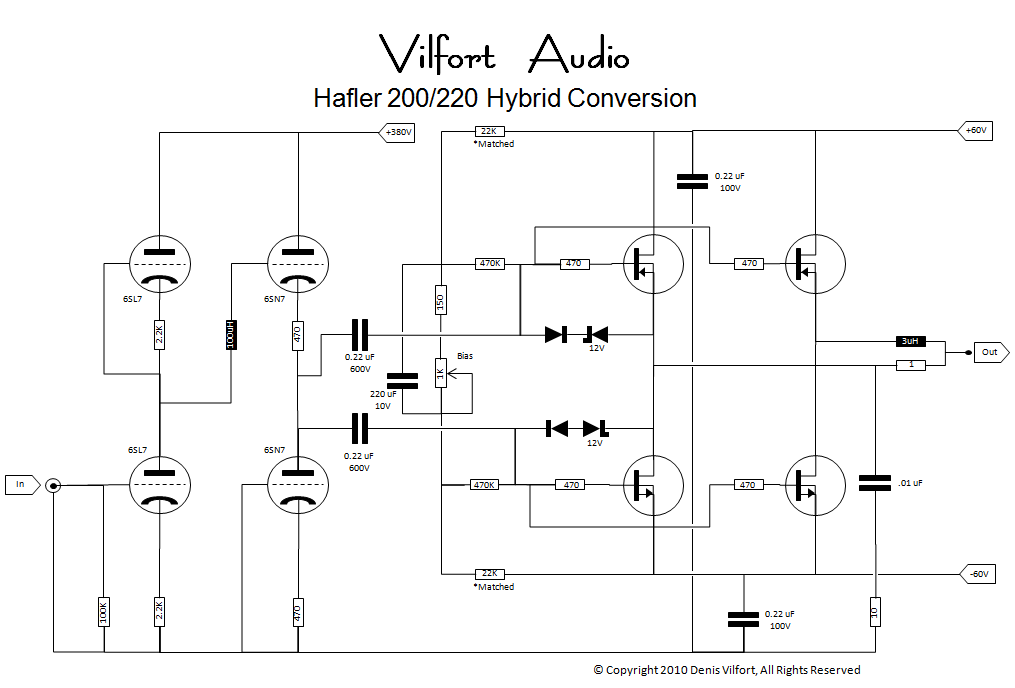

It all depends on what you are shooting for. I personally like the sound of tubes and have designed a bunch of 300B SE, 300B P-P and EL34 P-P amps. So for me fooling around with a tube conversion of an old Hafler seemed a fun project. It sounds great too: all the warmth and detail of tubes and the bass slam of a nice solid state output. I guess that's why folks like their Moscodes and Moskidos. Is it worth it? I say yes. This is of course a matter of taste. But you can take any old Hafler and make it sound better by upgrading caps on the driver board and bypassing/replacing the power supply caps. Cost? The Hafler should run you $70-$130 on Ebay and figure $50 to $100 for the extra parts (assuming the output MOSFETs are OK). What you end up with is a great sounding class AB amp that can go toe to toe with amps costing 10-20 times more. I have included the schematic for the Hafler tube conversion if you want to go that route (notice the zero feedback design and Aikaido-like tube section - Thx Broskie!).

That looks great and would have been exactly where i would head if i did not sell the unit and go for a moscode 300 which I must say is AMAZING!! My brother in law and i sat around all day Saturday listening to this amp shocked at how well it sounded. But thanks for the work on your end as it looks real nice and I might just build it anyway without the hafler amp.
Hafler tube conversion version 2
Like all amps, this one too needed to be listened to for a while... Well over the weekend it became crystal clear that the MOSFETs are VERY precise in their control of the speaker. Even without feedback... So the old Broskie Aikido setup started to reveal a bit of glare in the high treble.
I have used SRPP in the past and always liked the detail the topology provides - but with MOSFET output as opposed to say 300Bs and OPT it became very fatiguing to listen to. As a result, my wife left the room when I was playing at high levels. - That did it!
So back to the drawing board. We need a medium of voltage gain and low output impedance here. The easiest way to get there is two stages: a plate loaded voltage gain stage and a cathode follower. Since I already had the 6SL7 and 6SN7s plugged in, why not do a little math and leave the tubes in place? The result is half the tubes can go. We now have a 120K carbon comp plate load on the 6SL7 and 22K wire wound on the 6SN7s cathode (see attachment).
This helped a great deal. We still have all the detail – but midrange and treble is now a little more ‘airy’ and less harsh. Wide sound stage. Sounds very 'live' - and this one makes the speakers disappear!
So if you want to build something, try version 2 here. I have never heard the Moscode so I cannot compare. If you build it, please post your findings and comparisons with the Moscode.
Like all amps, this one too needed to be listened to for a while... Well over the weekend it became crystal clear that the MOSFETs are VERY precise in their control of the speaker. Even without feedback... So the old Broskie Aikido setup started to reveal a bit of glare in the high treble.
I have used SRPP in the past and always liked the detail the topology provides - but with MOSFET output as opposed to say 300Bs and OPT it became very fatiguing to listen to. As a result, my wife left the room when I was playing at high levels. - That did it!
So back to the drawing board. We need a medium of voltage gain and low output impedance here. The easiest way to get there is two stages: a plate loaded voltage gain stage and a cathode follower. Since I already had the 6SL7 and 6SN7s plugged in, why not do a little math and leave the tubes in place? The result is half the tubes can go. We now have a 120K carbon comp plate load on the 6SL7 and 22K wire wound on the 6SN7s cathode (see attachment).
This helped a great deal. We still have all the detail – but midrange and treble is now a little more ‘airy’ and less harsh. Wide sound stage. Sounds very 'live' - and this one makes the speakers disappear!
So if you want to build something, try version 2 here. I have never heard the Moscode so I cannot compare. If you build it, please post your findings and comparisons with the Moscode.
Attachments
Hi pidigi referring to the 2sa1209 & 2sc2911, there are other possibilities ofHi!
Reading back the previous posts I have seen that many of you consider the 3440/5415 a weak point in the Hafler circuit. A suggestion I have seen is to change them with 2SA1209 and 2SC2911. Is it really a sensible sonic improvement? Are there other candidates?
Ciao
Paolo
course but I suggest you read post 465 page 47 and associated pages of mods leading up to the reasons why these devices were suggested, it is unwise to take such a mod out of context from the original write-up, as these
changes were to be the icing on the cake so to speak, and as you would have already observed from your readings there are already many many mods that can improve this amplifier without going this far. regards
hafler mosfet checker reverse engineer?
Have you been able to reverse engineer this unit, so that those without access could grade their own mosfets?
Some 15-18 years ago there was an Audio Amateur article in which the author described how he regulated his DH-220 front ends. He used a Triad transformer that supplied ±85VDC which was then regulated down to around 65 VDC using an LM371. The controlling terminal was floating in a stack of zeners. Pretty straight forward circuit with 460mF cap on one side and around 1000 uF cap on the other. The entire thing was black boxed outboard with an umbilical to feed the PCBs inside the case.
It is instructive to note that the XL-280 has booster windings on its transformer to supply the PCBs with ~70 VDC. The extra voltage to the PCBs provides a few more watts of power. However I should I imagine that using a separate transformer for the PCB power supply would better decouple it from output power variations caused by heavy musical transients.
I match my MOSFETs using an original Hafler MOSFET checker. If you pay postage both ways I will match your devices for you and grade them 1 through 7, just as in the Hafler amps.
Have you been able to reverse engineer this unit, so that those without access could grade their own mosfets?
Richard: Yes, by using a torodial transformer (link here: 320V 50VA Toroidal Tube Pre Amp Transformer Guitar Amp - eBay (item 250596547118 end time Mar-20-10 19:44:30 PDT) ) and placing it right next to the power transformer on an L-bracket it fits nicely. The tube section can be built on stands and a mounting plate off the bottom of the chassis. Caps and cap brackets can also fit there. A few good solder lug strips help here. You may have to move the big power supply caps from the MOSFET section. But with a little care, it all fits. I have enclosed the tube section power supply schematic you asked for.
Attachments
- Home
- Amplifiers
- Solid State
- Hafler DH-200/220 Mods
